
- Usage in publication:
-
- Red Lake Falls Formation
- Modifications:
-
- Original reference
- Dominant lithology:
-
- Silt
- Sand
- Clay
- AAPG geologic province:
-
- Sioux uplift
- Williston basin
Summary:
Pg. 5 (fig. 2), 7 (fig. 3), 11-13, 30-31, 33-34 (measured sections). Red Lake Falls Formation. Brownish gray and olive-brown, unbedded pebble-loam. Consists of approximately equal amounts of silt and sand, and some clay (17 to 27 percent). Sand and gravel inclusions common, in thin beds (few mm), channel fills, and contorted masses. Jointed. Hard and resistant to erosion in dry outcrops and friable when moist. Thickness 7 to 70 feet in outcrop; averages 15 to 30 feet. Gradationally underlies Wylie Formation (new). Overlies St. Hilaire Formation (new); contact is sharp and gradational. Where St. Hilaire is absent, unconformably overlies Marcoux or Gervais Formation (both new). Lower part correlates with the Granite Falls [till] of Matsch, 1971 (Univ. Wisconsin, unpub. PhD dissert.) and the upper part correlates with the New Ulm [till] of Matsch, both in southwestern Minnesota. Is an extensive unit in outcrop and subsurface, in Minnesota, North Dakota, and Canada. Sediments deposited by glaciers advancing from the north and northwest. Age is considered Wisconsinan, based on stratigraphic relations; is younger to northwest in North Dakota (Clayton, 1966, North Dakota Geol. Survey Rpt. Inv., no. 44, 25 p.).
Type section [locality taken from index map (fig. 7) and measured section description (p. 30-31), and differs from what is given in text]: Clearwater section, right bank of Clearwater River, Red Lake Falls area, in NE/4 NE/4 sec. 22, T. 151 N., R. 44 W., Red Lake Falls 15-min quadrangle, Red Lake Co., northwestern MN.
Reference sections, in Red Lake Falls area, Red Lake Falls 15-min quadrangle, Red Lake Co., northwestern MN: (1) Needles Eye section, left bank of Red Lake River, in SW/4 NE/4 SE/4 sec. 18, T. 151 N., R. 43 W.; and (2) Damned House section, in SW/4 NE/4, SE/4 sec. 15, T. 151 N., R. 44 W.
Named from city of Red Lake Falls, Red Lake Co., northwestern MN.
Source: Publication.
For more information, please contact Nancy Stamm, Geologic Names Committee Secretary.
Asterisk (*) indicates published by U.S. Geological Survey authors.
"No current usage" (†) implies that a name has been abandoned or has fallen into disuse. Former usage and, if known, replacement name given in parentheses ( ).
Slash (/) indicates name conflicts with nomenclatural guidelines (CSN, 1933; ACSN, 1961, 1970; NACSN, 1983, 2005, 2021). May be explained within brackets ([ ]).

